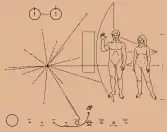Communication
Communication (from Latin: communicare, meaning "to share" or "to be in relation with")[1][2][3] is usually defined as the transmission of information. The term can also refer just to the message communicated or to the field of inquiry studying such transmissions. There are many disagreements about its precise definition.[4][5] John Peters argues that the difficulty of defining communication emerges from the fact that communication is both a universal phenomenon (because everyone communicates) and a specific discipline of institutional academic study.[6] One definitional strategy involves limiting what can be included in the category of communication (for example, requiring a "conscious intent" to persuade[7]). By this logic, one possible definition of communication is the act of developing meaning among entities or groups through the use of sufficiently mutually understood signs, symbols, and semiotic conventions.
| Communication |
|---|
.svg.png.webp) |
|
| General aspects |
|
| Fields |
|
| Disciplines |
| Categories |
|
An important distinction is between verbal communication, which happens through the use of a language, and non-verbal communication, for example, through gestures or facial expressions. Models of communication try to provide a detailed explanation of the different steps and entities involved. An influential model is given by Claude Shannon and Warren Weaver, who argue that communicative motivation prompts the sender to compose a message, which is then encoded and transmitted. Once it has reached its destination, it is decoded and interpreted by the receiver.[8][9][10] Communication is studied in various fields. Information theory investigates the quantification, storage, and communication of information in general. Communication studies is concerned with human communication while the science of biocommunication is interested in any form of communication between living organisms.
Communication can be realized visually (through images and written language), through auditory, tactile/haptic (e.g. Braille or other physical means), olfactory, electromagnetic, or biochemical means (or any combination thereof). Human communication is unique for its extensive use of abstract language.
Definitions
Communication is usually understood as the transmission of information.[11][12][13] In this regard, a message is conveyed from a sender to a receiver using some form of medium, such as sound, paper, bodily movements, or electricity.[14][15][16] In a different sense, the term "communication" can also refer just to the message that is being communicated or to the field of inquiry studying such transmissions.[11][13] There is a lot of disagreement concerning the precise characterization of communication and various scholars have raised doubts that any single definition can capture the term accurately. These difficulties come from the fact that the term is applied to diverse phenomena in different contexts, often with slightly different meanings.[17][18] Despite these problems, the question of the right definition is of great theoretical importance since it affects the research process on all levels. This includes issues like which empirical phenomena are observed, how they are categorized, which hypotheses and laws are formulated as well as how systematic theories based on these steps are articulated.[17] The word "communication" has its root in the Latin verb "communicare", which means "to share" or "to make common".[14]
Some theorists give very broad definitions of communication that encompass unconscious and non-human behavior.[17] In this regard, many animals communicate within their own species and even plants like flowers may be said to communicate by attracting bees.[14] Other researchers restrict communication to conscious interactions among human beings.[17][14] Some definitions focus on the use of symbols and signs while others emphasize the role of understanding, interaction, power, or transmission of ideas. Various characterizations see the communicator's intent to send a message as a central component. On this view, the transmission of information is not sufficient for communication if it happens unintentionally.[17] An important version of this view is given by Paul Grice, who identifies communication with actions that aim to make the recipient aware of the communicator's intention.[19] One question in this regard is whether only the successful transmission of information should be regarded as communication.[17] For example, distortion may interfere and change the actual message from what was originally intended.[15] A closely related problem is whether acts of deliberate deception constitute communication.[17]
According to an influential and broad definition by I. A. Richards, communication happens when one mind acts upon its environment in order to transmit its own experience to another mind.[18][20] Another important characterization is due to Claude Shannon and Warren Weaver. On their view, communication involves the interaction of several components, such as a source, a message, an encoder, a channel, a decoder, and a receiver.[18] The paradigmatic form of communication happens between two or several individuals. However, it can also take place on a larger level, for example, between organizations, social classes, or nations.[14] Niklas Luhmann rejects the view that communication is, on its most fundamental level, an interaction between two distinct parties. Instead, he holds that "only communication can communicate" and tries to provide a conceptualization in terms of autopoietic systems without any reference to consciousness or life.[21] John Peters sees communication as "an apparent answer to the painful divisions between self and other, private and public, and inner thought and outer world."[22]
Types
Verbal communication
Verbal communication is the spoken or written conveyance of a message. Human language can be defined as a system of symbols (also known as lexemes) and the grammars (rules) by which the symbols are manipulated. The word "language" also refers to common properties of languages. Language learning normally occurs most intensively during human childhood. Most of the large number of human languages use patterns of sound or gesture for symbols which enable communication with others around them. Languages tend to share certain properties, although there are exceptions. Constructed languages such as Esperanto, programming languages, and various mathematical formalisms are not necessarily restricted to the properties shared by human languages.
Communicators' diverse efforts to produce and interpret meaning in language are functionally constrained by that language's prototypical phonology (sounds that typically appear in a language), morphology (what counts as a word), syntax (word-order), semantics (conventional meaning of words), and pragmatics (which meanings are conventional to which contexts).
The meanings that are attached to words can be literal, or otherwise known as denotative; relating to the topic being discussed, or, the meanings take context and relationships into account, otherwise known as connotative; relating to the feelings, history, and power dynamics of the communicators.[23]
Contrary to popular belief, signed languages of the world (e.g., American Sign Language) are considered to be verbal communication because their sign vocabulary, grammar, and other linguistic structures abide by all the necessary classifications as spoken languages. There are however, nonverbal elements to signed languages, such as the speed, intensity, and size of signs that are made. A signer might sign "yes" in response to a question, or they might sign a sarcastic-large slow yes to convey a different nonverbal meaning. The sign yes is the verbal message while the other movements add nonverbal meaning to the message.
Written form
Over time the forms of and ideas about communication have evolved through the continuing progression of technology. Advances include communications psychology and media psychology, an emerging field of study.
The progression of written communication can be divided into three "information communication revolutions":[24]
- Written communication first emerged through the use of pictographs. The pictograms were made in stone, hence written communication was not yet mobile. Pictograms began to develop standardized and simplified forms.
- The next step occurred when writing began to appear on paper, papyrus, clay, wax, and other media with commonly shared writing systems. Communication became mobile.
- The final stage is characterized by the transfer of information through controlled waves of electromagnetic radiation (i.e., radio, microwave, infrared) and other electronic signals.
Communication is thus a process by which meaning is assigned and conveyed in an attempt to create shared understanding. Gregory Bateson called it "the replication of tautologies in the universe.[25] This process, which requires a vast repertoire of skills in interpersonal processing, listening, observing, speaking, questioning, analyzing, gestures, and evaluating enables collaboration[26][27] and cooperation.[28][29][30]
Non-verbal communication
Nonverbal communication explains the processes that convey a type of information in a form of non-linguistic representations. Examples of nonverbal communication include haptic communication, chronemic communication, gestures, body language, facial expressions, eye contact etc. Nonverbal communication also relates to the intent of a message. Examples of intent are voluntary, intentional movements like shaking a hand or winking, as well as involuntary, such as sweating.[31] Speech also contains nonverbal elements known as paralanguage, e.g. rhythm, intonation, tempo, and stress. It affects communication most at the subconscious level and establishes trust. Likewise, written texts include nonverbal elements such as handwriting style, the spatial arrangement of words and the use of emoticons to convey emotion.
Nonverbal communication demonstrates one of Paul Watzlawick's laws: you cannot not communicate. Once proximity has formed awareness, living creatures begin interpreting any signals received.[32] Some of the functions of nonverbal communication in humans are to complement and illustrate, to reinforce and emphasize, to replace and substitute, to control and regulate, and to contradict the denotative message.
Nonverbal cues are heavily relied on to express communication and to interpret others' communication and can replace or substitute verbal messages.
There are several reasons as to why non-verbal communication plays a vital role in communication:
- "Non-verbal communication is omnipresent."[33] They are included in every single communication act. To have total communication, all non-verbal channels such as the body, face, voice, appearance, touch, distance, timing, and other environmental forces must be engaged during face-to-face interaction. Written communication can also have non-verbal attributes. E-mails, web chats, and the social media have options to change text font colours, stationery, add emoticons, capitalization, and pictures in order to capture non-verbal cues into a verbal medium.[34]
- "Non-verbal behaviours are multifunctional."[35] Many different non-verbal channels are engaged at the same time in communication acts and allow the chance for simultaneous messages to be sent and received.
- "Non-verbal behaviours may form a universal language system."[35] Smiling, crying, pointing, caressing, and glaring are non-verbal behaviours that are used and understood by people regardless of nationality. Such non-verbal signals allow the most basic form of communication when verbal communication is not effective due to language barriers.
When verbal messages contradict non-verbal messages, observation of non-verbal behaviour is relied on to judge another's attitudes and feelings, rather than assuming the truth of the verbal message alone.
Non verbal communication can take the following forms:
- Paralinguistics are the elements other than language where the voice is involved in communication and includes tones, pitch, vocal cues etc. It also includes sounds from throat and all these are greatly influenced by cultural differences across borders.
- Proxemics deals with the concept of the space element in communication. Proxemics explains four zones of spaces, namely intimate, personal, social and public. This concept differs from culture to culture as the permissible space varies in different countries.
- Artifactics studies the non verbal signals or communication which emerges from personal accessories such as the dress or fashion accessories worn and it varies with culture as people of different countries follow different dress codes.
- Chronemics deals with the time aspects of communication and also includes the importance given to time. Some issues explaining this concept are pauses, silences and response lag during an interaction. This aspect of communication is also influenced by cultural differences as it is well known that there is a great difference in the value given by different cultures to time.
- Kinesics mainly deals with body language such as postures, gestures, head nods, leg movements, etc. In different countries, the same gestures and postures are used to convey different messages. Sometimes even a particular kinesic indicating something good in a country may have a negative meaning in another culture.
Communication models
Lasswells Model of Communication
Harold Lasswell is considered to be one of the primary founders of communication theories and he helped communications become a respected and legitimate study.[36][37] He developed the Lasswell Model of communication of communication during his professorship at Yale. It is now used as an umbrella term for other models of communication due to its simplicities to allow for multiple and very different interpretations to theorize with. It was published in "The Structure and Function of Communication in Society" essay in 1948. Lasswell was thinking about mass media and the role radio played in the 1930s. It was extremely popular after the second world war.[38]
The Lasswell model is broken into five parts-the five W's, it focuses on the "who", "what", "whom", "which Channel" and "what effect". Lasswell brings up that there is three functions of communication, there is surveillance of the environment, correlation of components of society and cultural transmission between generation.[39]
- Who, Communication is not only one person, it is newspapers, websites, television stations and radio stations. This communication is developed by people who run this organized institutions, reporters, editors etc.
- Says What, refers to analyzing and identifying the content that was given.
- To Whom, who is the audience and how does the audience receive this information,
- Which Channel, refers to the media and how it is going to analyzed. The interactivity of Media
- What effect, refers to what is taken from this piece of information
There are advantages as well as some critiques mentioned about the Lasswell Model. Some of the advantages are that the concept is easy and simple, it suits most types of communication and its the main concept of effect.
Some scholars believe that the Lasswell model of communication is no longer relevant, although at the time it was extremely significant. The critiques that have been brought up for the Lasswell model is the concept of feedback not mention, and the concept of noise is not mentioned. It was there where other theories started to come out to make up for the Lasswells method not having these factors in it, specially the Shannon and Weaver model. Another critique was that the Lasswell model is a linear model, it goes against other types of communications that show that it is more of a back and forth experience. It also does not mention power in the communication process.[40] Power was highlighted specially in Sturat Halls methods and concepts. Hall took parts from the Lasswell method and started reworking it to fit the idea of power in media, who has power and what message are they putting out. Hall examines how we view organizations and mass media and how they enforce certain meanings to appease their agenda.
Shannon and Weaver Model

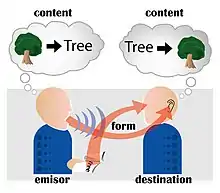
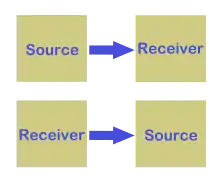
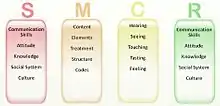
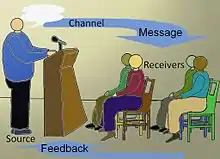

The first major model for communication was introduced by Claude Shannon and Warren Weaver for Bell Laboratories in 1949[41] The original model was designed to mirror the functioning of radio and telephone technologies. Their initial model consisted of three primary parts: sender, channel, and receiver. The sender was the part of a telephone a person spoke into, the channel was the telephone itself, and the receiver was the part of the phone where one could hear the other person. Shannon and Weaver also recognized that often there is static that interferes with one listening to a telephone conversation, which they deemed noise.
In a simple model, often referred to as the transmission model or standard view of communication, information or content (e.g. a message in natural language) is sent in some form (as spoken language) from an emitter (emisor in the picture)/sender/encoder to a destination/receiver/decoder. This common conception of communication simply views communication as a means of sending and receiving information. The strengths of this model are simplicity, generality, and quantifiability. Claude Shannon and Warren Weaver structured this model based on the following elements:
- The formation of communicative motivation or reason.
- Message composition (further internal or technical elaboration on what exactly to express).
- Message encoding (for example, into digital data, written text, speech, pictures, gestures and so on).
- Transmission of the encoded message as a sequence of signals using a specific channel or medium.
- Noise sources such as natural forces and in some cases human activity (both intentional and accidental) begin influencing the quality of signals propagating from the sender to one or more receivers.
- Reception of signals and reassembling of the encoded message from a sequence of received signals.
- Decoding of the reassembled encoded message.
- Interpretation and making sense of the presumed original message.
These elements are now understood to be substantially overlapping and recursive activities rather than steps in a sequence.[42] For example, communicative actions can start before a communicator formulates a conscious attempt to do so,[43] as in the case of phatics; likewise, communicators modify their intentions and formulations of a message in response to real-time feedback (e.g., a change in facial expression).[44] Practices of decoding and interpretation are culturally enacted, not just by individuals (genre conventions, for instance, trigger anticipatory expectations for how a message is to be received), and receivers of any message operationalize their own frames of reference in interpretation.[45]
Shannon and Weaver argued that there were three levels of problems for communication within this theory.
- The technical problem: how accurately can the message be transmitted?
- The semantic problem: how precisely is the meaning conveyed?
- The effectiveness problem: how effectively does the received meaning affect behavior?
Daniel Chandler[46] critiques the transmission model by stating:
- It assumes communicators are isolated individuals.
- No allowance for differing purposes.
- No allowance for differing interpretations.
- No allowance for unequal power relations.
- No allowance for situational contexts.
In 1960, David Berlo expanded on Shannon and Weaver's (1949) linear model of communication and created the SMCR Model of Communication.[47] The Sender-Message-Channel-Receiver Model of communication separated the model into clear parts and has been expanded upon by other scholars.
Communication is usually described along a few major dimensions: message (what type of things are communicated), source/emisor/sender/encoder (from whom), form (in which form), channel (through which medium), destination/receiver/target/decoder (to whom). Wilbur Schram (1954) also indicated that we should also examine the impact that a message has (both desired and undesired) on the target of the message.[48] Between parties, communication includes acts that confer knowledge and experiences, give advice and commands, and ask questions. These acts may take many forms, in one of the various manners of communication. The form depends on the abilities of the group communicating. Together, communication content and form make messages that are sent towards a destination. The target can be oneself, another person or being, another entity (such as a corporation or group of beings).
Communication can be seen as processes of information transmission with three levels of semiotic rules:
- Pragmatic (concerned with the relations between signs/expressions and their users).
- Semantic (study of relationships between signs and symbols and what they represent).
- Syntactic (formal properties of signs and symbols).
Therefore, communication is social interaction where at least two interacting agents share a common set of signs and a common set of semiotic rules. This commonly held rule in some sense ignores autocommunication, including intrapersonal communication via diaries or self-talk, both secondary phenomena that followed the primary acquisition of communicative competences within social interactions.
In light of these weaknesses, Barnlund (2008) proposed a transactional model of communication.[49] The basic premise of the transactional model of communication is that individuals are simultaneously engaging in the sending and receiving of messages.
In a slightly more complex form a sender and a receiver are linked reciprocally. This second attitude of communication, referred to as the constitutive model or constructionist view, focuses on how an individual communicates as the determining factor of the way the message will be interpreted. Communication is viewed as a conduit; a passage in which information travels from one individual to another and this information becomes separate from the communication itself. A particular instance of communication is called a speech act. The sender's personal filters and the receiver's personal filters may vary depending upon different regional traditions, cultures, or gender; which may alter the intended meaning of message contents. In the presence of "communication noise" on the transmission channel (air, in this case), reception and decoding of content may be faulty, and thus the speech act may not achieve the desired effect. One problem with this encode-transmit-receive-decode model is that the processes of encoding and decoding imply that the sender and receiver each possess something that functions as a codebook, and that these two code books are, at the very least, similar if not identical. Although something like code books is implied by the model, they are nowhere represented in the model, which creates many conceptual difficulties.
Theories of coregulation describe communication as a creative and dynamic continuous process, rather than a discrete exchange of information. Canadian media scholar Harold Innis had the theory that people use different types of media to communicate and which one they choose to use will offer different possibilities for the shape and durability of society.[50] His famous example of this is using ancient Egypt and looking at the ways they built themselves out of media with very different properties stone and papyrus. Papyrus is what he called 'Space Binding'. it made possible the transmission of written orders across space, empires and enables the waging of distant military campaigns and colonial administration. The other is stone and 'Time Binding', through the construction of temples and the pyramids can sustain their authority generation to generation, through this media they can change and shape communication in their society.[50]
As an academic discipline
The academic discipline that deals with processes of human communication is communication studies. The discipline encompasses a range of topics, from face-to-face conversation to mass media outlets such as television broadcasting. Communication studies also examines how messages are interpreted through the political, cultural, economic, semiotic, hermeneutic, and social dimensions of their contexts. Statistics, as a quantitative approach to communication science, has also been incorporated into research on communication science in order to help substantiate claims.[51]
Organizational communication
Business communication is used for a wide variety of activities including, but not limited to: strategic communications planning, media relations, internal communications, public relations (which can include social media, broadcast and written communications, and more), brand management, reputation management, speech-writing, customer-client relations, and internal/employee communications.
Companies with limited resources may choose to engage in only a few of these activities, while larger organizations may employ a full spectrum of communications. Since it is relatively difficult to develop such a broad range of skills, communications professionals often specialize in one or two of these areas but usually have at least a working knowledge of most of them. By far, the most important qualifications communications professionals must possess are excellent writing ability, good 'people' skills, and the capacity to think critically and strategically.
Business communication could also refer to the style of communication within a given corporate entity (i.e. email conversation styles, or internal communication styles).
The Classical Approach:
The classical approach comes from the management theory by Frederick Taylor who was the founder of the scientific management theory as well.[52] The main idea of the classical approach of organizational communication is that the theory compares organizations to a machine. The theory observed and analyze that workers perform the task they are given to in order to contribute to the overall well-being of the organization. Each member has their purpose in the group, just like a part of a machine works does its tasks while cooperate with other parts to have a well-managed, functioning machine. Additionally, just like a machine that collapse when one part fails to function. An organization will fall apart when members are not doing their designated task appropriately.[53]
The Human Relation Approach:
The human relation approach is based from several different theorists such as: Elton Mayo, McGregors's Douglas, Abraham Maslow, Mary Parker Follett's and Argyris.[52] The main idea of the human relation approach of organizational communication is that the theory compares organizations to a family. As this theory compares organization to a family, it focuses on workers satisfaction and the relationship within the organizations more compared to the work performance element.[54] The human relation approach emphasizes the importance of employee attitudes, and encourage organizations management team to focus on interpersonal relationships, group dynamics, and leadership styles in achieving organizational effectiveness.[55]
Political communication
Communication is one of the most relevant tools in political strategies, including persuasion and propaganda. In mass media research and online media research, the effort of the strategist is that of getting a precise decoding, avoiding "message reactance", that is, message refusal. The reaction to a message is referred also in terms of approach to a message, as follows:
- In "radical reading" the audience rejects the meanings, values, and viewpoints built into the text by its makers. Effect: message refusal.
- In "dominant reading", the audience accepts the meanings, values, and viewpoints built into the text by its makers. Effect: message acceptance.
- In "subordinate reading" the audience accepts, by and large, the meanings, values, and worldview built into the text by its makers. Effect: obey to the message.[56]
Holistic approaches are used by communication campaign leaders and communication strategists in order to examine all the options, "actors" and channels that can generate change in the semiotic landscape, that is, change in perceptions, change in credibility, change in the "memetic background", change in the image of movements, of candidates, players and managers as perceived by key influencers that can have a role in generating the desired "end-state".
The modern political communication field is highly influenced by the framework and practices of "information operations" doctrines that derive their nature from strategic and military studies. According to this view, what is really relevant is the concept of acting on the Information Environment. The information environment is the aggregate of individuals, organizations, and systems that collect, process, disseminate, or act on information. This environment consists of three interrelated dimensions, which continuously interact with individuals, organizations, and systems. These dimensions are known as physical, informational, and cognitive.[57]
Interpersonal communication
In simple terms, interpersonal communication is the communication between one person and another (or others). It is often referred to as face-to-face communication between two (or more) people. Both verbal and nonverbal communication, or body language, play a part in how one person understands another, and attribute to one's own soft skills. In verbal interpersonal communication there are two types of messages being sent: a content message and a relational message. Content messages are messages about the topic at hand and relational messages are messages about the relationship itself.[58] This means that relational messages come across in how one says something and it demonstrates a person's feelings, whether positive or negative, towards the individual they are talking to, indicating not only how they feel about the topic at hand, but also how they feel about their relationship with the other individual.[58]
There are many different aspects of interpersonal communication including:
- Audiovisual Perception of Communication Problems.[59] The concept follows the idea that our words change what form they take based on the stress level or urgency of the situation. It also explores the concept that stuttering during speech shows the audience that there is a problem or that the situation is more stressful.
- The Attachment Theory.[60] This is the combined work of John Bowlby and Mary Ainsworth (Ainsworth & Bowlby, 1991) This theory follows the relationships that builds between a mother and child, and the impact it has on their relationships with others.
- Emotional Intelligence and Triggers.[61] Emotional Intelligence focuses on the ability to monitor ones own emotions as well as those of others. Emotional Triggers focus on events or people that tend to set off intense, emotional reactions within individuals.
- Attribution Theory.[62] This is the study of how individuals explain what causes different events and behaviors.
- The Power of Words (Verbal communications).[63] Verbal communication focuses heavily on the power of words, and how those words are said. It takes into consideration tone, volume, and choice of words.
- Nonverbal Communication. It focuses heavily on the setting that the words are conveyed in, as well as the physical tone of the words.
- Ethics in Personal Relations.[64] It is about a space of mutual responsibility between two individuals, it's about giving and receiving in a relationship. This theory is explored by Dawn J. Lipthrott in the article What IS Relationship? What is Ethical Partnership?
- Deception in Communication.[65] This concept goes into that everyone lies, and how this can impact relationships. This theory is explored by James Hearn in his article Interpersonal Deception Theory: Ten Lessons for Negotiators.
- Conflict in Couples.[66] This focuses on the impact that social media has on relationships, as well as how to communicate through conflict. This theory is explored by Amanda Lenhart and Maeve Duggan in their paper Couples, the Internet, and Social Media.
Family communication
Family communication is the study of the communication perspective in a broadly defined family, with intimacy and trusting relationship.[67] The main goal of family communication is to understand the interactions of family and the pattern of behaviors of family members in different circumstances. Open and honest communication creates an atmosphere that allows family members to express their differences as well as love and admiration for one another. It also helps to understand the feelings of one another.
Family communication study looks at topics such as family rules, family roles or family dialectics and how those factors could affect the communication between family members. Researchers develop theories to understand communication behaviors. Family communication study also digs deep into certain time periods of family life such as marriage, parenthood or divorce and how communication stands in those situations. It is important for family members to understand communication as a trusted way which leads to a well constructed family.
Rhetoric
According to scholar Anne Beaufort, communication is also interested in rhetoric as a method of investigating "oral and written communications, particularly with regard to the desired effect on an audience, and lately, with visual communications as well."[68]
Barriers to effectiveness
Barriers to effective communication can distort the message or intention of the message being conveyed. This may result in failure of the communication process or cause an effect that is undesirable. These include filtering, selective perception, information overload, emotions, language, silence, communication apprehension, gender differences and political correctness.[69]
Noise
In any communication model, noise is interference with the decoding of messages sent over the channel by an encoder. To face communication noise, redundancy and acknowledgement must often be used. Acknowledgements are messages from the addressee informing the originator that his/her communication has been received and is understood.[70] Message repetition and feedback about message received are necessary in the presence of noise to reduce the probability of misunderstanding.
The act of disambiguation regards the attempt of reducing noise and wrong interpretations, when the semantic value or meaning of a sign can be subject to noise, or in presence of multiple meanings, which makes the sense-making difficult. Disambiguation attempts to decrease the likelihood of misunderstanding. This is also a fundamental skill in communication processes activated by counselors, psychotherapists, interpreters, and in coaching sessions based on colloquium. In Information Technology, the disambiguation process and the automatic disambiguation of meanings of words and sentences has also been an interest and concern since the earliest days of computer treatment of language.[71]
Cultural aspects
Cultural differences exist within countries (tribal/regional differences, dialects and so on), between religious groups and in organisations or at an organisational level – where companies, teams and units may have different expectations, norms and idiolects. Families and family groups may also experience the effect of cultural barriers to communication within and between different family members or groups. For example: words, colours and symbols have different meanings in different cultures. In most parts of the world, nodding your head means agreement, shaking your head means "no", but this is not true everywhere.[72]
Communication to a great extent is influenced by culture and cultural variables.[73][74][75][76] Understanding cultural aspects of communication refers to having knowledge of different cultures in order to communicate effectively with cross culture people. Cultural aspects of communication are of great relevance in today's world which is now a global village, thanks to globalisation. Cultural aspects of communication are the cultural differences which influence communication across borders. So in order to have an effective communication across the world it is desirable to have a knowledge of cultural variables effecting communication.
According to Michael Walsh and Ghil'ad Zuckermann, Western conversational interaction is typically "dyadic", between two particular people, where eye contact is important and the speaker controls the interaction; and "contained" in a relatively short, defined time frame. However, traditional Aboriginal conversational interaction is "communal", broadcast to many people, eye contact is not important, the listener controls the interaction; and "continuous", spread over a longer, indefinite time frame.[77][78]
Nonhuman
Every information exchange between living organisms — i.e. transmission of signals that involve a living sender and receiver can be considered a form of communication; and even primitive creatures such as corals are competent to communicate. Nonhuman communication also include cell signaling, cellular communication, and chemical transmissions between primitive organisms like bacteria and within the plant and fungal kingdoms.
Animals
The broad field of animal communication encompasses most of the issues in ethology. Animal communication can be defined as any behavior of one animal that affects the current or future behavior of another animal. The study of animal communication, called zoo semiotics (distinguishable from anthroposemiotics, the study of human communication) has played an important part in the development of ethology, sociobiology, and the study of animal cognition. Animal communication, and indeed the understanding of the animal world in general, is a rapidly growing field, and even in the 21st century so far, a great share of prior understanding related to diverse fields such as personal symbolic name use, animal emotions, animal culture and learning, and even sexual conduct, long thought to be well understood, has been revolutionized.
Plants and fungi
Communication is observed within the plant organism, i.e. within plant cells and between plant cells, between plants of the same or related species, and between plants and non-plant organisms, especially in the root zone. Plant roots communicate with rhizome bacteria, fungi, and insects within the soil. Recent research has shown that most of the microorganism plant communication processes are neuron-like.[79] Plants also communicate via volatiles when exposed to herbivory attack behavior, thus warning neighboring plants.[80] In parallel they produce other volatiles to attract parasites which attack these herbivores.
Fungi communicate to coordinate and organize their growth and development such as the formation of mycelia and fruiting bodies. Fungi communicate with their own and related species as well as with non fungal organisms in a great variety of symbiotic interactions, especially with bacteria, unicellular eukaryote, plants and insects through biochemicals of biotic origin. The biochemicals trigger the fungal organism to react in a specific manner, while if the same chemical molecules are not part of biotic messages, they do not trigger the fungal organism to react. This implies that fungal organisms can differentiate between molecules taking part in biotic messages and similar molecules being irrelevant in the situation. So far five different primary signalling molecules are known to coordinate different behavioral patterns such as filamentation, mating, growth, and pathogenicity. Behavioral coordination and production of signaling substances is achieved through interpretation processes that enables the organism to differ between self or non-self, a biotic indicator, biotic message from similar, related, or non-related species, and even filter out "noise", i.e. similar molecules without biotic content.
Pheromones are molecules released by one organism into the external environment to influence other individuals of the same species. Thus pheromone release is a form of communication. Pheromones promote sexual interaction (mating) in several fungal species. These include the aquatic fungus Allomyces macrogynus, the Mucorales fungus Mucor mucedo, Neurospora crassa and the yeasts Saccharomyces cerevisiae, Schizosaccharomyces pombe and Rhodosporidium toruloides.[81][82][83]
Bacteria quorum sensing
Communication is not a tool used only by humans, plants and animals, but it is also used by microorganisms like bacteria. The process is called quorum sensing. Through quorum sensing, bacteria can sense the density of cells, and regulate gene expression accordingly. This can be seen in both gram positive and gram negative bacteria. This was first observed by Fuqua et al. in marine microorganisms like V. harveyi and V. fischeri.[84]
Natural bacterial transformation involves the transfer of naked DNA from one bacterium to another through the surrounding medium, and can be regarded as a relatively simple form of sexual interaction. In several bacterial species transformation is promoted by the production of an extracellular factor, termed a competence factor, that when released into the surrounding medium induces a state of competence in neighboring cells. The state of competence is the ability to take up the DNA released by another cell. Bacterial competence factors are similar to pheromones in multicellular organisms. Competence factors have been studied in Bacillus subtilis[85] and Streptococcus pneumoniae.[86]
See also
- 21st century skills
- Advice
- Augmentative and alternative communication
- Bias-free communication
- Communication rights
- Context as Other Minds
- Cross-cultural communication
- Data transmission
- Error detection and correction
- Human communication
- Information engineering
- Inter mirifica
- Intercultural communication
- Ishin-denshin
- Group dynamics
- Language
- Mass communication
- Proactive communications
- Sign system
- Signal
- Small talk
- SPEAKING
- Telepathy
- Understanding
- Writing
References
- Cobley, Paul (2008-06-05), "Communication: Definitions and Concepts", in Donsbach, Wolfgang (ed.), The International Encyclopedia of Communication, Chichester, UK: John Wiley & Sons, Ltd, pp. wbiecc071, doi:10.1002/9781405186407.wbiecc071, ISBN 978-1-4051-8640-7, archived from the original on 2021-12-07, retrieved 2021-07-20
- Harper, Douglas. "communication". Online Etymology Dictionary. Retrieved 2013-06-23.
- "What Is Communication?". 2012books.lardbucket.org. Archived from the original on 2021-12-09. Retrieved 2021-03-23.
- Dance, Frank E. X. (1970-06-01). "The "Concept" of Communication". Journal of Communication. 20 (2): 201–210. doi:10.1111/j.1460-2466.1970.tb00877.x. ISSN 0021-9916. Archived from the original on 2021-10-18. Retrieved 2021-07-21.
- Craig, Robert T. (1999). "Communication Theory as a Field". Communication Theory. 9 (2): 119–161. doi:10.1111/j.1468-2885.1999.tb00355.x. Archived from the original on 2022-07-30. Retrieved 2021-07-21.
- Peters, John Durham (1986). "Institutional Sources of Intellectual Poverty in Communication Research". Communication Research. 13 (4): 527–559. doi:10.1177/009365086013004002. ISSN 0093-6502. S2CID 145639228. Archived from the original on 2021-12-07. Retrieved 2021-07-21.
- Miller, Gerald R. (1966-06-01). "On Defining Communication: Another Stab". Journal of Communication. 16 (2): 88–98. doi:10.1111/j.1460-2466.1966.tb00020.x. ISSN 0021-9916. PMID 5941548. Archived from the original on 2022-07-30. Retrieved 2021-07-21.
- Fiske, John (1982): Introduction to Communication Studies. London: Routledge
- Chandler, Daniel (18 September 1995). "The Transmission Model of Communication". Archived from the original on 2021-05-06.
- Shannon, Claude E. & Warren Weaver (1949). A Mathematical Model of Communication. Urbana, IL: University of Illinois Press
- Publishers, HarperCollins. "communication". www.ahdictionary.com. Retrieved 27 September 2022.
- "communication". www.merriam-webster.com. Retrieved 27 September 2022.
- "communication". Cambridge Dictionary. Retrieved 27 September 2022.
- Rosengren, Karl Erik (11 February 2000). "1.1 On communication". Communication: An Introduction. SAGE. ISBN 978-0-8039-7837-9.
- Munodawafa, D. (1 June 2008). "Communication: concepts, practice and challenges". Health Education Research. 23 (3): 369–370. doi:10.1093/her/cyn024. PMID 18504296.
- Blackburn, Simon (1996). "Meaning and communication". In Craig, Edward (ed.). Routledge Encyclopedia of Philosophy. Routledge.
- Dance, Frank E. X. (1 June 1970). "The "Concept" of Communication". Journal of Communication. 20 (2): 201–210. doi:10.1111/j.1460-2466.1970.tb00877.x.
- Gordon, George N. "communication". www.britannica.com. Retrieved 27 September 2022.
- Blackburn, Simon (1996). "Intention and communication". In Craig, Edward (ed.). Routledge Encyclopedia of Philosophy. Routledge.
- Nöth, Winfried (1995). Handbook of Semiotics. Indiana University Press. p. 172. ISBN 978-0-253-20959-7.
- Luhmann, Niklas (August 1992). "What is Communication?". Communication Theory. 2 (3): 251–259. doi:10.1111/j.1468-2885.1992.tb00042.x.
- Peters, John Durham (1999). Speaking into the air : a history of the idea of communication. Chicago: University of Chicago Press. p. 2. ISBN 0-226-66276-4. OCLC 40452957. Archived from the original on 2022-07-30. Retrieved 2021-07-24.
- Ferguson, Sherry Devereaux; Lennox-Terrion, Jenepher; Ahmed, Rukhsana; Jaya, Peruvemba (2014). Communication in Everyday Life: Personal and Professional Contexts. Canada: Oxford University Press. p. 464. ISBN 9780195449280. Archived from the original on 2020-04-15. Retrieved 2019-08-20.
- Xin Li. "Complexity Theory – the Holy Grail of 21st Century". Lane Dept of CSEE, West Virginia University. Archived from the original on 2013-08-15.
- Bateson, Gregory (1960). Steps to an Ecology of Mind.
- AIIM. "What is Collaboration?". www.aiim.org. Archived from the original on 2022-06-23. Retrieved 2022-07-22.
- "What is Collaboration?". aiim. Archived from the original on 23 June 2022. Retrieved 22 July 2022.
- "communication". The office of superintendent of Public Instruction. Washington.
{{cite web}}: Missing or empty|url=(help) - "Communication Skills: Definitions and Examples | Indeed.com India". In.indeed.com. Archived from the original on 2022-07-22. Retrieved 2022-07-24.
- "Written Communication: Characteristics and Importance (Advantages and Limitations)". Your article library. 24 February 2014. Archived from the original on 19 March 2022. Retrieved 22 July 2022.
- "Types of Body Language". Simplybodylanguage.com. Archived from the original on 2016-03-10. Retrieved 2016-02-08.
- Wazlawick, Paul (1970's) opus
- (Burgoon, J., Guerrero, L., Floyd, K., (2010). Nonverbal Communication, Taylor & Francis. p. 3 )
- Martin-Rubió, Xavier (2018-09-30). Contextualising English as a Lingua Franca: From Data to Insights. Cambridge Scholars Publishing. ISBN 978-1-5275-1696-0. Archived from the original on 2021-02-04. Retrieved 2020-10-02.
- (Burgoon et al., p. 4)
- Ascher, William; Muth, Rodney; Finley, Mary M.; Muth, Marcia (September 1992). "Harold D. Lasswell: An Annotated Bibliography". Political Psychology. 13 (3): 589. doi:10.2307/3791617. ISSN 0162-895X. JSTOR 3791617. Archived from the original on 2022-07-30. Retrieved 2022-04-09.
- Berelson, Bernard (1959). "The State of Communication Research". Public Opinion Quarterly. 23 (1): 1. doi:10.1086/266840. ISSN 0033-362X. Archived from the original on 2022-07-30. Retrieved 2022-04-09.
- Lasswell, Harold D. (April 1936). "The Encyclopedia of the Social Sciences in ReviewEncyclopedia of the Social Sciences". The International Journal of Ethics. 46 (3): 388–396. doi:10.1086/intejethi.46.3.2989274. ISSN 1526-422X. S2CID 144206130. Archived from the original on 2022-07-30. Retrieved 2022-04-09.
- Wenxiu, Peng (2015-09-01). "Analysis of New Media Communication Based on Lasswell's "5W" Model". Journal of Educational and Social Research. doi:10.5901/jesr.2015.v5n3p245. ISSN 2239-978X. Archived from the original on 2022-07-30. Retrieved 2022-04-09.
- Sapienza, Zachary S.; Iyer, Narayanan; Veenstra, Aaron S. (2015-09-03). "Reading Lasswell's Model of Communication Backward: Three Scholarly Misconceptions". Mass Communication and Society. 18 (5): 599–622. doi:10.1080/15205436.2015.1063666. ISSN 1520-5436. S2CID 146389958. Archived from the original on 2022-06-18. Retrieved 2022-04-09.
- Shannon, C.E., & Weaver, W. (1949). The mathematical theory of communication. Urbana, Illinois: University of Illinois Press
- Reddy, Michael J. (1979). "The Conduit Metaphor -- A Case of Frame Conflict in our Language about Language." In Metaphor and Thought, Andrew Ortony, ed. Cambridge UP: 284-324.
- Cooper, Marilyn M. (2019). The Animal Who Writes. Pittsburgh: University of Pittsburgh Press. pp. 127–156. ISBN 978-0-8229-6579-4.
- Rommetveit, Ragnar (1974). On Message Structure: A Framework for the Study of Language and Communication. London: John Wiley & Sons. ISBN 0-471-73295-8.
- Witte, Stephen P. (1992). "Context, Text, Intertext: Toward a Constructivist Semiotic of Writing". Written Communication. 9 (2): 237–308. doi:10.1177/0741088392009002003. S2CID 143717668.
- Daniel Chandler, "The Transmission Model of Communication", Aber.ac.uk Archived January 6, 2010, at the Wayback Machine
- Berlo, D.K. (1960). The process of communication. New York: Holt, Rinehart & Winston.
- Schramm, W. (1954). How communication works. In W. Schramm (Ed.), The process and effects of communication (pp. 3–26). Urbana, Illinois: University of Illinois Press.
- Barnlund, D.C. (2008). A transactional model of communication. In. C.D. Mortensen (Eds.), Communication theory (2nd ed., pp. 47–57). New Brunswick, New Jersey: Transaction.
- Wark, McKenzie (1997). The Virtual Republic. Allen & Unwin, St Leonards.
- Hayes, Andrew F. (31 May 2005). Statistical Methods for Communication Science. Taylor & Francis. pp. 8–9. ISBN 9781410613707. Archived from the original on 4 February 2021. Retrieved 20 August 2019.
- EVALUATE THE INFLUENCE OF CLASSICAL AND HUMAN RELATIONS APPROACHES IN MANAGEMENT TODAY
- "Classical Theories of Organizational Communication". Dec 3, 2020. Archived from the original on July 30, 2022. Retrieved March 4, 2022.
{{cite journal}}: Cite journal requires|journal=(help) - Cooley, Scott (2017). Human Relations Theory of Organization. GLOBAL ENCYCLOPEDIA OF PUBLIC ADMINISTRATION, PUBLIC POLICY, AND GOVERNANCE. ISBN 9783319318165.
- "American Psychological Association". APA Dictionary of Psychology. Archived from the original on March 4, 2022. Retrieved March 4, 2022.
- Danesi, Marcel (2009), Dictionary of Media and Communications. M.E.Sharpe, Armonk, New York.
- "Chairman of the Joint Chiefs of Staff, U.S. Army (2012). Information Operations. Joint Publication 3-13. Joint Doctrine Support Division, 116 Lake View Parkway, Suffolk, VA" (PDF). Dtic.mil. Archived from the original (PDF) on 2017-05-04. Retrieved 2017-05-01.
- Trenholm, Sarah; Jensen, Arthur (2013). Interpersonal Communication Seventh Edition. New York: Oxford University Press. pp. 360–361.
- Barkhuysen, P., Krahmer, E., Swerts, M., (2004) Audiovisual Perception of Communication Problems, ISCA Archive http://www.isca-speech.org/archive Archived 2017-03-29 at the Wayback Machine
- Bretherton, I., (1992) The Origins of Attachment Theory: John Bowlby and Mary Ainsworth, Developmental Psychology, 28, 759-775
- Mazza, J., Emotional Triggers, MABC, CPC
- Bertram, M., (2004) How the Mind Explains Behavior: Folk Explanations, Meaning, and Social Interaction, MIT Press, ISBN 978-0-262-13445-3
- "Listening". 2012books.lardbucket.org. Archived from the original on 2016-11-19. Retrieved 2017-05-01.
- Lipthrott, D., What IS Relationship? What is Ethical Partnership?
- Hearn, J., (2006) Interpersonal Deception Theory: Ten Lessons for Negotiators
- Lenhart, A., Duggan, M., (2014) Couples, the Internet, and Social Media
- Turner, L.H., & West, R.L. (2013). Perspectives on family communication. Boston: McGraw-Hill.
- Beaufort, Anne. "Rhetorical Studies, Communications, and Composition Studies: Disparate or Overlapping Discourse Communities." The Realms of Rhetoric.
- Robbins, S., Judge, T., Millett, B., & Boyle, M. (2011). Organisational Behaviour. 6th ed. Pearson, French's Forest, NSW pp. 315–317.
- North Atlantic Treaty Organization, NATO Standardization Agency AAP-6 – Glossary of terms and definitions, p. 43.
- Nancy Ide, Jean Véronis. "Word Sense Disambiguation: The State of the Art", Computational Linguistics, 24(1), 1998, pp. 1–40.
- Nageshwar Rao, Rajendra P. Das, Communication skills, Himalaya Publishing House, 9789350516669, p. 48
- "The Communication and Cognitive Components of Culture". Archived from the original on 2013-07-18. Retrieved 2012-09-29.
- "Incorrect Link to Beyond Intractability Essay". Beyond Intractability. 2017-04-18. Archived from the original on 2013-07-30. Retrieved 2017-05-01.
- "Important Components of Cross-Cultural Communication Essay". Studymode.com. Archived from the original on 2017-06-19. Retrieved 2017-05-01.
- "Portable Document Format (PDF)". Ijdesign.org. Archived from the original on 2017-05-14. Retrieved 2017-05-01.
- Zuckermann, Ghil'ad; et al. (2015), Engaging – A Guide to Interacting Respectfully and Reciprocally with Aboriginal and Torres Strait Islander People, and their Arts Practices and Intellectual Property (PDF), Australian Government: Indigenous Culture Support, p. 12, archived from the original (PDF) on 30 March 2016, retrieved 25 June 2016
- Walsh, Michael (1997), Cross cultural communication problems in Aboriginal Australia, Australian National University, North Australia Research Unit, pp. 7–9, ISBN 9780731528745, archived from the original on 13 August 2016, retrieved 25 June 2016
- Baluska, F.; Marcuso, Stefano; Volkmann, Dieter (2006). Communication in plants: neuronal aspects of plant life. Taylor & Francis US. p. 19. ISBN 978-3-540-28475-8. Archived from the original on 2016-05-12. Retrieved 2015-11-15.
...the emergence of plant neurobiology as the most recent area of plant sciences.
- Ian T. Baldwin; Jack C. Schultz (1983). "Rapid Changes in Tree Leaf Chemistry Induced by Damage: Evidence for Communication Between Plants". Science. 221 (4607): 277–279. Bibcode:1983Sci...221..277B. doi:10.1126/science.221.4607.277. PMID 17815197. S2CID 31818182.
- O’Day, D.H. (1981). Modes of cellular communicatin and sexual interactions in eukaryotic microbes. In: Sexual Interactions in Eukaryotic Microbes. (O’Day, D.H. & Horgen, P.A., eds), pp. 3-17. New York: Academic Press
- Davey, J. (March 1992). "Mating pheromones of the fission yeast Schizosaccharomyces pombe: purification and structural characterization of M-factor and isolation and analysis of two genes encoding the pheromone". The EMBO Journal. 11 (3): 951–960. doi:10.1002/j.1460-2075.1992.tb05134.x. PMC 556536. PMID 1547790.
- Akada, Rinji; Minomi, Kenjiro; Kai, Jingo; Yamashita, Ichiro; Miyakawa, Tokichi; Fukui, Sakuzo (August 1989). "Multiple genes coding for precursors of rhodotorucine A, a farnesyl peptide mating pheromone of the basidiomycetous yeast Rhodosporidium toruloides". Molecular and Cellular Biology. 9 (8): 3491–3498. doi:10.1128/mcb.9.8.3491-3498.1989. PMC 362396. PMID 2571924.
- Anand, Sandhya. Quorum Sensing- Communication Plan For Microbes Archived 2012-03-26 at the Wayback Machine. Article dated 2010-12-28, retrieved on 2012-04-03.
- Akrigg, A.; Ayad, S. R. (1970-04-01). "Studies on the competence-inducing factor of Bacillus subtilis". Biochemical Journal. 117 (2): 397–403. doi:10.1042/bj1170397. PMC 1178873. PMID 4986873.
- Håvarstein, L S; Coomaraswamy, G; Morrison, D A (1995-11-21). "An unmodified heptadecapeptide pheromone induces competence for genetic transformation in Streptococcus pneumoniae". Proceedings of the National Academy of Sciences. 92 (24): 11140–11144. Bibcode:1995PNAS...9211140H. doi:10.1073/pnas.92.24.11140. PMC 40587. PMID 7479953.
Further reading
| Library resources about communication |
- Innis, Harold; Innis, Mary Q. (1975) [1950]. Empire and Communications. Foreword by Marshall McLuhan (Revised ed.). Toronto: University of Toronto Press. ISBN 978-0-8020-6119-5. OCLC 19403451.
External links
 Quotations related to Communication at Wikiquote
Quotations related to Communication at Wikiquote Media related to Communication at Wikimedia Commons
Media related to Communication at Wikimedia Commons
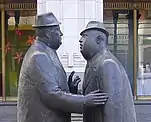
.jpg.webp)



